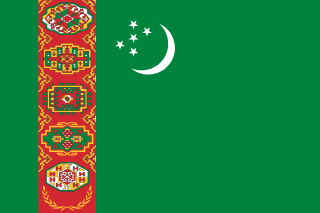Turkmenistan - Geography

Here, let us take a look at the Geography of Turkmenistan. Landlocked; the western and central low-lying desolate portions of the country make up the great Garagum (Kara-Kum) desert, which occupies over 80% of the country; eastern part is plateau. Mother's mean age at first birth is 24.2 years (2019) (), whereas, the Maternal mortality ratio is 5 deaths/100,000 live births (2023 est.)
Geographical data of Turkmenistan
| Location | Central Asia, bordering the Caspian Sea, between Iran and Kazakhstan |
|---|---|
| Geographic coordinates | 40 00 N, 60 00 E |
| Map references | Asia |
| Tarrain | flat-to-rolling sandy desert with dunes rising to mountains in the south; low mountains along border with Iran; borders Caspian Sea in west |
| Natural Resources | petroleum, natural gas, sulfur, salt |
| Natural Hazards | earthquakes; mudslides; droughts; dust storms; floods |
| Irrigated Land | 16,459 sq km (2012) |
| Major rivers (by length in km) | Amu Darya (shared with Tajikistan [s], Afghanistan, and Uzbekistan [m]) - 2,620 km note: [s] after country name indicates river source; [m] after country name indicates river mouth |
| Major aquifers | |
| Land Boundaries | 4,158 km |
| Border Countries | Afghanistan 804 km; Iran 1,148 km; Kazakhstan 413 km; Uzbekistan 1,793 km |
| Coastline | 0 km (landlocked) |
| Climate | subtropical desert |
| Area | |
| Total Area | |
| Land Area | 469,930 sq km |
| Water Area | 18,170 sq km |
| comparative Area | slightly more than three times the size of Georgia; slightly larger than California |
| Maritime Claims | |
| Elevations | |
| Highest point | Gora Ayribaba 3,139 m |
| Lowest point | Vpadina Akchanaya (Sarygamysh Koli is a lake in northern Turkmenistan with a water level that fluctuates above and below the elevation of Vpadina Akchanaya, the lake has dropped as low as -110 m) -81 m |
| Mean elevation | 230 m |
| Land Use | |
| Agricultural land | 84.2% (2023 est.) |
| Agricultural land: arable land | arable land: 3.4% (2023 est.) |
| Agricultural land: permanent crops | permanent crops: 0.1% (2023 est.) |
| Agricultural land: permanent pasture | permanent pasture: 80.8% (2023 est.) |
| Forest | 5% (2023 est.) |
| Other | 10.7% (2023 est.) |
Population Distribution
The most densely populated areas are the southern, eastern, and northeastern oases; approximately 50% of the population lives in and around the capital of Ashgabat
People and Society
In Turkmenistan, the different Ethnic groups are such that we have: Turkmen 85%, Uzbek 5%, Russian 4%, other 6% (2003 est.)
| Population | |
|---|---|
| Pop growth rate | 0.92% (2024 est.) |
| Birth rate | 16.8 births/1,000 population (2024 est.) |
| Death rate | 6 deaths/1,000 population (2024 est.) |
| Health expenditure | |
| Physicians Density | |
| Hospital bed Density | 4 beds/1,000 population (2021 est.) |
| Total fertility rate | 2.02 children born/woman (2024 est.) |
| Gross reproduction rate | 0.99 (2024 est.) |
| Contraceptive prevalence rate | |
| Est married women (ages 15-49) | 64.3% (2023 est.) |
| Literacy | |
| Education expenditures | |
| Net Migration rate | -1.7 migrant(s)/1,000 population (2024 est.) |
| Nationality | Turkmenistani | Turkmenistani(s) |
| Languages | |
| Religions | Muslim 93%, Christian 6.4%, Buddhist <1%, folk religion <1%, Jewish <1%, other <1%, unspecified <1% (2020 est.) |
| Age Structure | |
| 0-14 years | 24.5% (male 711,784/female 692,967) |
| 15-64 years | 68.6% (male 1,956,740/female 1,984,333) |
| 65 years and over | 6.9% (2024 est.) (male 174,346/female 223,981) |
| Dependency Ratios | |
| Total dependency ratio | 45.8 (2024 est.) |
| Youth dependency ratio | 35.6 (2024 est.) |
| Elderly dependency ratio | 10.1 (2024 est.) |
| Potential support ratio | 9.9 (2024 est.) |
| Median Age | |
| Total | 31.2 years (2024 est.) |
| Male | 30.7 years |
| Female | 31.7 years |
| Urbanization | |
| Urban population | 54% of total population (2023) |
| Rate of urbanization | 2.23% annual rate of change (2020-25 est.) |
| Major urban areas (Pop) | 902,000 ASHGABAT (capital) (2023). |
| Sex Ratio | |
| At birth | 1.05 male(s)/female |
| 0-14 years | 1.03 male(s)/female |
| 15-64 years | 0.99 male(s)/female |
| 65 years and over | 0.78 male(s)/female |
| Total population | 0.98 male(s)/female (2024 est.) |
| Infant Motality | |
| Total | 35.9 deaths/1,000 live births (2024 est.) |
| Male | 43.6 deaths/1,000 live births |
| Female | 27.7 deaths/1,000 live births |
| Life Expectancy at birth | |
| Total population | 72.4 years (2024 est.) |
| Male | 69.4 years |
| Female | 75.5 years |
| Drinking Water Sources | |
| Improved: urban | urban: 100% of population (2022 est.) |
| Improved: rural | rural: 100% of population (2022 est.) |
| Improved: total | total: 100% of population (2022 est.) |
| Unimproved: urban | urban: 0% of population (2022 est.) |
| Unimproved: rural | rural: 0% of population (2022 est.) |
| Unimproved: total | total: 0% of population (2022 est.) |
| Sanitation facility acess | |
| Improved: urban | urban: 99.8% of population (2022 est.) |
| Improved: rural | rural: 100% of population (2022 est.) |
| Improved: total | total: 99.9% of population (2022 est.) |
| Unimproved: urban | urban: 0.2% of population (2022 est.) |
| Unimproved: rural | rural: 0% of population (2022 est.) |
| Unimproved: total | total: 0.1% of population (2022 est.) |
| Alcohol consumption per capita | |
| Total | 2.88 liters of pure alcohol (2019 est.) |
| Beer | 0.65 liters of pure alcohol (2019 est.) |
| Wine | 1.25 liters of pure alcohol (2019 est.) |
| Spirits | 0.98 liters of pure alcohol (2019 est.) |
| Other alcohols | 0 liters of pure alcohol (2019 est.) |
| Tobacco use | |
| Total | 4.8% (2025 est.) |
| Male | 9.4% (2025 est.) |
| Female | 0.5% (2025 est.) |
| Child marriage | |
| Women married by age 15 | 0.2% (2019) |
| Women married by age 18 | 6.1% (2019) |
Demographic profile
All Important Facts about Turkmenistan
Want to know more about Turkmenistan? Check all different factbooks for Turkmenistan below.
-
 Turkmenistan Factbook
Turkmenistan Factbook
-
 The Economy of Turkmenistan
The Economy of Turkmenistan
-
 Learn about the Government of Turkmenistan
Learn about the Government of Turkmenistan
-
 Communication in Turkmenistan
Communication in Turkmenistan
-
 Popular Universities in Turkmenistan
Popular Universities in Turkmenistan
-
 Enerny in Turkmenistan
Enerny in Turkmenistan
-
 Transport in Turkmenistan
Transport in Turkmenistan
-
 The Geography and society of Turkmenistan
The Geography and society of Turkmenistan
-
 The Environment of Turkmenistan
The Environment of Turkmenistan
-
 Military and security in Turkmenistan
Military and security in Turkmenistan